

10th May 2025 (13 Topics)
Mains Issues
Context
A report in the Wall Street Journal (WSJ) revealed that U.S. intelligence officials had been gathering intelligence on Greenland — particularly:
- Greenland’s independence movement
- Public opinion on U.S. mineral extraction projects
The Backdrop (Trump’s 2019 “Buy Greenland” Proposal)
- In 2019, then-President Donald Trump publicly floated the idea of buying Greenland from Denmark.
- Denmark and Greenland outright rejected the idea.
- Trump then cancelled a state visit to Denmark, calling the PM’s reaction “nasty” — which strained diplomatic relations.
- Trump later said he was serious about the idea due to Greenland's strategic value.
US’s interests in Greenland
Greenland, a semi-autonomous part of Denmark, became strategically important for the U.S. during World War II when the U.S. established its military base, which remains today as Pituffik Space Base. Greenland is increasingly seen as strategically critical due to three major factors:
- Arctic Military Importance: The Arctic is melting rapidly due to climate change, opening new shipping lanes and access to natural resources.
- The U.S. operates the Thule Air Base in northern Greenland — a key radar and missile warning site.
- Greenland sits between North America and Europe, making it important for ballistic missile tracking and early warning systems.
- Mineral & Resource Richness: Greenland is believed to hold vast deposits of rare earth minerals, oil, natural gas, and uranium- resources critical to modern electronics and defense industries. As countries decarbonize, competition over such critical minerals is intensifying, especially between the S. and China.
- China’s Arctic Ambitions: China is investing in infrastructure and mining in Greenland and calls itself a “near-Arctic state”. The U.S. sees this as part of China’s polar strategy to gain a foothold in the Arctic.
Hence, the U.S. sees Greenland as strategically vital to national security, economic interests, and great power rivalry in the Arctic.
Implications for India
- Arctic geopolitics now involves strategic minerals, shipping routes, and climate science — all important for India’s energy security and foreign policy.
- India is an observer in the Arctic Council and has released its Arctic Policy (2022). Events like this shape the rules-based order India wants to see in the region.
- Also raises questions for India’s own intelligence diplomacy — how to balance cooperation with key allies while avoiding similar controversies.
About Greenland
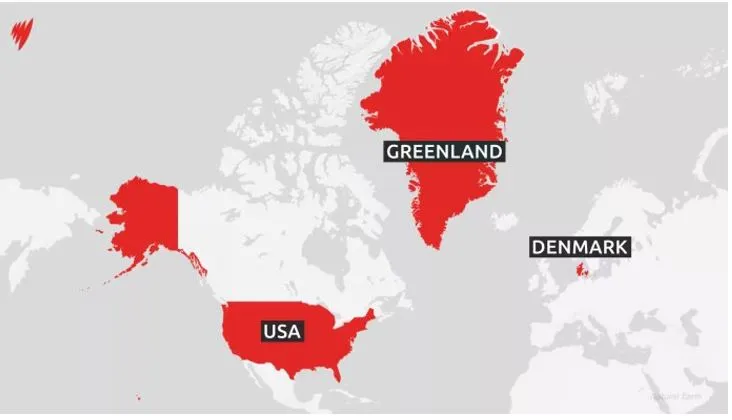 |


Mains Issues
Context
The International Monetary Fund (IMF) has authorised the "immediate disbursement" of a billion-dollar bailout to Pakistan's troubled economy. The Washington-based global lender said its decision allows for an "immediate disbursement of around USD 1 billion, bringing total disbursements under the arrangement to about USD 2.1 billion".
Who Decides at the IMF?
- At the core of the IMF’s governance structure is the Executive Board, which is responsible for making most of the operational decisions—including approvals of loans, reviewing economic performance, and setting policy directions.
- The Executive Board consists of 25 Executive Directors.
- Each Director represents either one country (like the S., China, India) or a constituency/group of countries (especially smaller or developing economies that pool their representation).
- The Board meets regularly in Washington, D.C., and acts like the IMF’s steering committee.
- How Do They Vote? – Weighted Voting System
- Unlike the UN's "one country, one vote" system, the IMF uses a "quota-based" voting system.
- A country’s voting power is proportional to its economic size—i.e., the bigger and richer your economy, the more say you have.
- No “No” Votes – Only “Yes” or “Abstain”: In IMF decision-making, Executive Directors cannot vote “No.”
- The only options are:
- Yes
- Abstain (used to show dissent or reservations). Abstention becomes the strongest form of protest within the IMF framework. It signals non-approval without breaching procedural norms.
India’s Role and Recent Abstention
- India is a member of the Executive Board and represents a constituency of South Asian countries.
- In the recent case of IMF loans to Pakistan, India chose to abstain to express strong disapproval, citing:
- Risk of funds being misused
- Pakistan’s track record with previous programmes
- Security concerns related to terrorism
India's Objection:
India has strongly objected to the IMF's financial support to Pakistan.
- Misuse of Funds: India fears that financial assistance may be diverted to support state-sponsored terrorism, especially cross-border terrorism targeting India.
- Poor Track Record: Pakistan has a history of non-compliance with IMF conditions. India argues that repeated bailouts without accountability undermine the credibility of reform-based lending.
- Geopolitical Risk: Such funding may indirectly empower military establishments in Pakistan, especially when India-Pakistan tensions are high.
- Reputational Risk: Lending to a country with unresolved issues of terrorism and non-transparency risks the IMF’s global reputation and its commitment to responsible governance.
India abstained from the vote and issued a strong protest note, saying this support sends a "dangerous message" to the global community.
IMF and Lending Controversies
- Western Dominance: Decision-making is heavily influenced by major shareholders like the USA, leading to charges of geopolitical bias.
- Austerity Burdens: IMF programmes often impose harsh conditions like subsidy cuts, tax increases, and privatisation—these hurt the poor and increase inequality.
- Moral Hazard: Countries that repeatedly fail to reform may still receive bailouts, encouraging irresponsible economic behaviour.
- Lack of Local Context: IMF’s one-size-fits-all approach ignores ground realities in borrowing countries.
- Undermining Sovereignty: IMF-mandated reforms are often seen as external interference in national policymaking.
What is the IMF?
|


Mains Issues
Context
India thwarted a large-scale drone assault by Pakistan along its western front. Over 300 drones targeted both civilian and military sites. Investigations revealed these were Turkish-made Asisguard Songar drones, deepening concerns about the growing Pakistan–Turkey defence partnership.
Why are Pakistan and Turkey so close?
- Both countries have a long history of solidarity based on Islamic identity, dating back to the Cold War era, when they were part of Western-sponsored alliances like CENTO (Central Treaty Organization).
- Turkey and Pakistan were also founding members of RCD (Regional Cooperation for Development), highlighting an early intent to foster close regional cooperation.
- Turkey has consistently supported Pakistan’s position on Kashmir, vocally opposing India’s revocation of Article 370 in 2019 and reiterating that stance even during major bilateral visits, such as Erdogan’s trip to Pakistan in 2025.
- Military and Defence Ties: Turkey is now Pakistan’s second-largest arms supplier, after China. In recent years, Turkish military exports to Pakistan have included:
- Bayraktar TB2 drones
- Kemankes cruise missiles
- Asisguard Songar drones
- A USD 1 billion deal for four Turkish corvettes (Ada-class) for Pakistan Navy.
- Turkish firms are modernising Pakistan’s Agosta 90B submarines, bypassing original French suppliers, showing high levels of trust and strategic depth in military collaboration.
Turkey’s Larger Ambitions (What's in it for Ankara?)
- Regional Leadership in the Muslim World: Turkey sees itself as a leader of the Islamic world, challenging the Gulf states—particularly Saudi Arabia and the UAE—who have traditionally held this position.
- Strategic Footprint in the Indian Ocean Region (IOR): Turkey has strengthened its military presence in East Africa (Somalia) and is deepening ties with Maldives through drone sales. Close collaboration with Pakistan — whose navy is among the largest in the IOR — gives Turkey indirect access to a region of growing global importance.
- Economic and Defence Industry Growth: Turkey is diversifying its defence export markets, and Pakistan serves as a reliable buyer. This helps Turkey promote indigenous defence firms like STM, Baykar, and Asisguard, reducing reliance on NATO countries.
How has India responded?
India has not remained passive. While it has lodged formal protests against Turkish interference in Kashmir, its response has been strategically multi-layered, aiming to counterbalance the Pak-Turkey axis through geopolitical, defence, and diplomatic initiatives:
- Strengthening Ties with Turkey’s Regional Rivals
- Greece and Cyprus: India has long supported Cyprus and its territorial integrity, opposing Turkish claims over Northern Cyprus. Greece has reciprocated by backing India’s Kashmir stance.
- Armenia: India has emerged as Armenia’s largest arms supplier in 2024, surpassing Russia. Armenia is in a long-standing conflict with Turkey-backed Azerbaijan, which is also allied with Pakistan.
- Enhanced Presence in the Middle East: Despite the traditional Pakistan-Gulf link, India now enjoys strong economic and security partnerships with Saudi Arabia and the UAE.
- Strategic Projects that Bypass Turkey: India-Middle East-Europe Economic Corridor (IMEC), launched at the G20 summit in 2023, excludes Turkey, which has historically seen itself as a key land bridge between Asia and Europe.
Why does the Pakistan–Turkey nexus matter for India?
- Security Threat: Turkey’s drone exports and naval cooperation with Pakistan pose direct threats to Indian borders and maritime interests.
- Diplomatic Headwinds: Turkey amplifies Pakistan’s voice on Kashmir at global platforms, such as the UN and OIC.
- Regional Competition: As Turkey expands its presence in the IOR and Central Asia, India must recalibrate its own regional influence strategies.
- Challenging Multilateral Balances: The Pak-Turkey-Azerbaijan bloc is increasingly visible in Islamic geopolitics, pushing against India's alignment with Israel, Armenia, Greece, and moderate Arab states.
Turkey’s Songar drones
|


Mains Issues
Context
The 23rd Annual South Asia Press Freedom Report 2024–25, titled "Frontline Democracy: Media and Political Churn", has been released.
Key Highlights of the Report
- Out of 180 countries assessed, 160 face significant challenges regarding the financial stability of media outlets, notably affected in theUnited States (ranked 57th, a decline of 2 places from the previous year)
- Nepal stands at 90th, followed by the Maldives (104), Sri Lanka (139), Bangladesh (149), India (151), Bhutan (152), Pakistan (158), and Afghanistan (175).
- Non-Press Freedom Challenges:
- Shrinking job opportunities and freelance insecurity
- AI-driven content reducing demand for human journalists
- Decline in advertising revenue
- Contractualisation under new labour codes
- Corporate consolidations harming editorial independence
- India-Specific Observations: India ranked 151st with a total score of 32.96 in the World Press Freedom Index in 2025, moving up 8 places from 159th last year.
- Systemic Suppression of Media: The report states that Indian media is being “shackled” under a systemic strategy to cripple independent journalism.
- Legal Intimidation: Increasing use of laws such as defamation, sedition, UAPA, and PMLA has created a hostile legal environment. These laws are often used to target media houses critical of the government.
- Chilling Effect and Self-Censorship: Due to legal harassment, surveillance, and arbitrary detentions, self-censorship is on the rise, weakening press accountability.
- IT Cells and Disinformation: Political party “IT cells” are contributing to hate speech, propaganda, and disinformation, exacerbating the trust deficit in media.
- State Pressure Tactics:
- Income Tax and ED raids
- Withholding of government advertisements
- Surveillance and intimidation of journalists
- National Security as Pretext: Restrictions on speech and press freedom are being justified in the name of public order, national security, and countering misinformation.
- Misinformation as a Global Risk: Referring to the Global Risks Report 2024, India is identified as the country facing the highest risk from misinformation and disinformation.
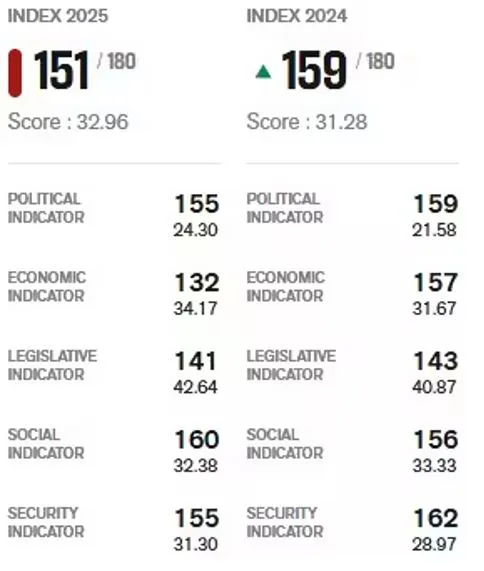
World Press Freedom Index 2025
|


Mains Issues
Context
The Supreme Court of India (SC) recently overturned a Delhi High Court order that had directed Wikipedia to take down a page related to an ongoing defamation case filed by ANI, stating that courts should not direct media or platforms to delete content unless it amounts to contempt. The ruling has sparked important discussions on media freedom, judicial transparency, and criticism of court proceedings.
Background of the Case
- The case involves a legal conflict between:
- ANI (Asian News International) – a news agency that filed a defamation suit,
- and Wikimedia Foundation, the non-profit that hosts Wikipedia.
- The matter originated when ANI objected to a Wikipedia page that contained:
- Details of court proceedings in its defamation case.
- Critical remarks or editorial discussions on the court’s handling of the issue.
- Specifically, the page criticized a Delhi High Court judge’s direction to reveal the identities of Wikipedia editors involved in the page content.
- In October 2024, a division bench of the Delhi High Court ordered Wikimedia to take down the page, considering it interference with court proceedings and a possible violation of the sub judice principle.
What the Supreme Court Said?
- The Supreme Court of India made some key constitutional observations:
- Freedom of the Press and Judicial Criticism: The Court strongly defended the idea that public institutions, including the judiciary, should remain open to public scrutiny and criticism.
- It said that constructive debates and criticism about court proceedings—even those ongoing—are vital for democracy.
- "Courts should welcome debate... even if the issue is before a court."
- It is not the role of courts to tell the media or digital platforms what content to delete or retain.
This draws a clear line between judicial responsibility and editorial discretion or platform moderation.
Key Legal and Constitutional Dimensions
- Freedom of Speech & Expression (Article 19(1)(a)): The ruling strengthens the constitutional guarantee of free speech, particularly freedom of the press and freedom to report on judicial processes.
- Criticism of a court’s order, even if sharp, is not automatically contempt, unless it undermines public confidence in the judiciary in a malicious manner.
- Contempt of Court vs Legitimate Criticism: The Court clarified that if any article scandalises the judiciary or judges, proper contempt proceedings can be initiated.
- But courts must not pre-emptively restrict publication unless there's clear and present danger to the administration of justice.
- This brings in the standard from the Contempt of Courts Act, 1971, where “fair criticism” is not contempt.
- Doctrine of Sub Judice: The High Court had claimed that the Wikipedia article violated the sub judice rule — meaning, public discussion of ongoing cases could influence judicial outcomes.
- The SC, however, took a broader view: public discussion of pending cases isn't inherently wrong, especially when it's informative or critical rather than prejudicial.
This shows a shift away from a “paternalistic view of public discourse”, toward “greater transparency”.
Digital Rights & Platform Autonomy
- The case also has a digital governance angle. Wikipedia is an open-source, collaborative platform.
- The ruling protects platforms like Wikipedia from judicial overreach unless absolutely necessary, preserving digital autonomy and free flow of information.
This is especially relevant as India tightens regulations on digital platforms through rules like the IT Rules, 2021.
Significance of the Judgment
- The Judgment sets a strong precedent for press freedom in reporting court matters.
- It protects online platforms from broad and vague take-down orders.
- It defines limits of contempt of court, ensuring judges and courts aren't insulated from criticism.
- It reasserts judiciary’s openness to democratic oversight and transparency.
- Furthermore, it encourages a more mature public discourse, without the fear of judicial censorship.
India's legal system for permitting digital speech
|


Prelims Articles
Context
In order to benefit farmers through tech-driven agri projects, the Uttar Pradesh government and World Bank launched two flagship programmes:
- UP-AGRIS – to boost agriculture and rural livelihoods
- AI Pragya – to train the youth in emerging digital technologies like Artificial Intelligence (AI)
What is UP-AGRIS?
- ‘UP-AGRIS’ stands for Uttar Pradesh - Advanced Growth of Rural and Inclusive Sustainable Agriculture.
- It is a Rs 4,000 crore World Bank-supported programme to modernize agriculture and related sectors in UP.
- Key Objectives
- Promote technology-driven farming in Purvanchal and Bundelkhand (historically underdeveloped regions).
- Enhance farm productivity and climate resilience.
- Empower 10 lakh farmers, including a focus on women and marginalized groups.
- Why Purvanchal and Bundelkhand? These regions:
- Face frequent droughts, low productivity, and rural poverty.
- Have large agrarian populations with limited access to modern inputs.
- Need targeted investments to bridge the development gap with western UP.
What is AI Pragya?
- AI Pragya is a programme to train 10 lakh youth across UP in: Artificial Intelligence (AI). Machine Learning (ML), Data Analytics and Cybersecurity and more.
- Main Aims
- Prepare the workforce for Industry 4.0.
- Boost employment and entrepreneurship.
- Make UP an AI and tech hub.
- Youth will get certified training.
- The initiative promotes tech-based startups, especially in semi-urban and rural areas.
- It supports Digital India and Skill India


Prelims Articles
Context
India and New Zealand concluded the first round of negotiations for a proposed Free Trade Agreement (FTA).
Key-highlights
- India and New Zealand's bilateral trade relationship has seen a sharp upward trajectory in recent years with merchandise trade between the two countries reaching USD1.3 billion in 2024–25, a growth of 48.6 percent on-year.
- The FTA is expected to further elevate trade and investment potential, improve supply chain integration, and foster a predictable and transformative trading environment for businesses on both sides.
- Key-items for trade:
- Exports to New Zealand include clothing, fabrics, and home textiles; medicines and medical supplies; refined petrol; agricultural equipment and machinery such as tractors and irrigation tools; auto; iron and steel; paper products; electronics; shrimps; diamonds; and basmati rice.
- Imports from New Zealand: Agricultural goods, minerals, apples, kiwifruit, meat products such as lamb, mutton, milk albumin, lactose syrup, coking coal, logs and sawn timber, wool, and scrap metals
- India has recently agreed upon a FTA with UK and is currently negotiating trade deals with a slew of nations and blocs including European Union, United States and Oman.
Why India and New Zealand Matter to Each Other?
- India's Importance for New Zealand
- Large Market: India’s 1.4 billion population and rising middle class offer strong demand for dairy, meat, and wine exports.
- Skilled Manpower: India is NZ’s largest source of skilled migrants and 2nd-largest source of international students.
- Digital Ecosystem: India’s 880 million internet users offer opportunities for digital services, AI, and fintech.
- Strategic Alignment: India's Indo-Pacific role supports NZ's regional stability
- New Zealand's Importance for India
- Agricultural Modernization: Expertise in dairy, food logistics, and horticulture supports Indian farm reforms.
- Education & Skill Development: Offers vocational training and high-quality tertiary education.
- Climate Tech Partner: NZ firms feature in HolonIQ Indo-Pacific Climate Tech 100—relevant to India's green goals.
- Maritime & Defence: Potential buyer of Indian radars, patrol vessels, aligning with NZ’s Pacific maritime concerns.


Prelims Articles
Context
India announced that the Indian Armed Forces had "neutralised" an air defence system located in Lahore, Pakistan. India’s Integrated Counter-UAS Grid and Air Defence Systems successfully intercepted and neutralised those incoming threats. In retaliation, India struck back, targeting air defence radars and systems at various locations in Pakistan.
What is an Air Defence System?
- An air defence system is a multi-layered military setup used to detect, track, and neutralise aerial threats—such as enemy aircraft, missiles, and drones.
- These systems are critical for protecting cities, military installations, and strategic infrastructure.
- Core Components:
- Radars – to detect and track incoming objects using radio waves.
- Command and Control Units – to process information and decide whether to engage.
- Surface-to-Air Missiles (SAMs) – to intercept and destroy the threat in mid-air.
- Jammers and Signal Disruptors – to confuse enemy guidance systems.
- Alert Systems – including air raid sirens and communication networks.
- Working of the System:
- Detection: Radar stations continuously monitor airspace for any suspicious or fast-moving object.
- Identification: Once something is detected, systems assess whether it’s a friend or foe using identification protocols.
- Engagement Decision: If identified as a threat, the system calculates:
- How fast and high it is moving
- What direction it's coming from
- What kind of threat it is (missile, aircraft, drone, etc.)
- Interception: A surface-to-air missile (SAM) or another weapon is launched. It either destroys the aircraft or missile, or detonates it mid-air before it can reach its target.
Note: A missile is self-propelled and guided, while a bomb typically falls freely under gravity. This distinction affects how air defences respond.
What does ‘Neutralised’ mean in Military Terms?
To neutralise an air defence system generally means that it has been:
- Destroyed
- Disabled or jammed
- Rendered inoperable through cyber or electronic warfare
- Targeted in a way that removes its ability to detect or respond to air threats
In this case, Lahore’s air defence system was likely taken out either physically (by missile/airstrike) or through electronic/cyber interference, making the city vulnerable to further aerial attacks, if India chose to proceed.
India’s Air Defence Systems
|

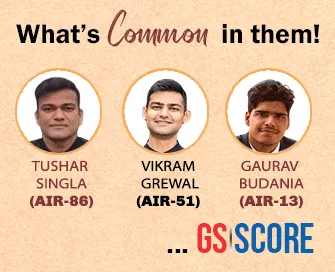
Prelims Articles
Context
To counter the surge in cyberattacks on Indian digital entities following the Pahalgam terror attack, the Computer Emergency Response Team (CERT-In), has issued special instructions to financial institutions and critical sectors to strengthen their cyber defences. Most recent cyber incidents have involved distributed denial-of-service (DDoS) attacks and attempts to deface Indian websites.
About
- Distributed Denial-of-Service (DDoS) Attack is a cybercrime in which the attacker floods a server with internet traffic to prevent users from accessing connected online services and sites.
- It is a type of DoS attack that comes from many distributed sources such as a botnet DDoS attack.
- A denial-of-service (DoS) attack is a type of cyber attack in which a malicious actor aims to render a computer or other device unavailable to its intended users by interrupting the device's normal functioning.
- DDoS attacks disrupt websites by flooding servers with traffic, causing downtime and potential financial losses.
- Defacement of websites involve vandalising the website to spread a message, usually political in nature.
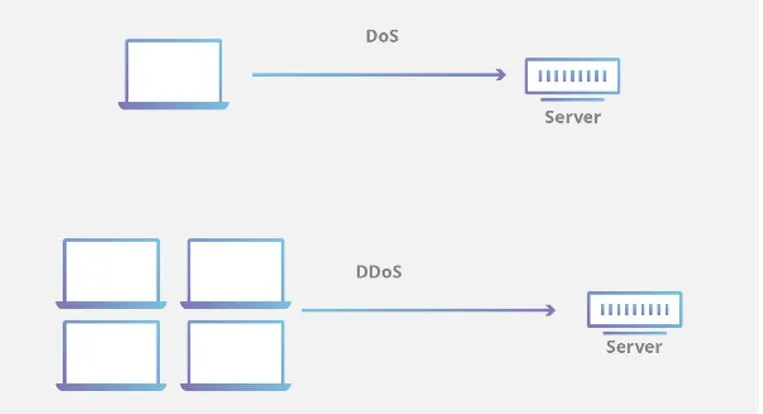


Prelims Articles
Context
'World Thalassaemia Day' is celebrated every year on 8 May to spread awareness about this disease.
What is Thalassemia?
- Thalassemia is an inherited blood disorder that affect the body’s ability to produce normal hemoglobin, leading to chronic anemia.
- It is caused by mutations in the HBB gene responsible for beta-globin production.
- Hemoglobin is made of two proteins:
- Alpha globin
- Beta globin
- Thalassemia occurs when there is a variant in a gene that helps control production of one of these proteins.
- It leads to excessive destruction of red blood cells and causing anemia.
- It is genetic and can range from mild to severe, requiring regular blood transfusions or lifelong management.
- There are two main types:
- Thalassemia Minor (carrier state) – usually asymptomatic.
- Thalassemia Major (disease state) – requires lifelong transfusions.
- The disease burden is aggravated by low awareness, intra-community marriages, and poor early screening practices.
- India sees 10,000 to 15,000 babies born with Thalassemia Major every year (NHM 2016).


Editorials
Context
The Indian Armed Forces conducted ‘Operation Sindoor’ in response to a Pakistan-sponsored terror attack in Pahalgam, Jammu & Kashmir, exposing the direct nexus between Pakistan’s military establishment and terrorist groups like Lashkar-e-Taiba (LeT) and Jaish-e-Mohammed (JeM). The operation signaled a decisive shift in India's counter-terrorism posture, with deep strikes across Pakistan's military and terror infrastructure.
Pakistan's State-Terror Nexus: Irrefutable Proof
- Blurring of State–Non-State Distinction: Evidence from Pahalgam attack and aftermath shows complete erosion of the line between Pakistan's state actors and terror outfits like JeM and LeT.
- State-Backed Martyrdom: Video footage confirms state funerals for killed terrorists with attendance of Pakistan Army officers — a clear legitimisation of terror actors by the state.
- Escalation by Pakistan: In response to India’s precision strikes, Pakistan launched missile and drone attacks on both civilian and military targets in Jammu & Kashmir, Punjab, and Rajasthan, marking a serious escalation.
India’s Calibrated Military Response
- Legitimacy of ‘Operation Sindoor’: The operation was grounded in Article 51 of the UN Charter (Right to Self-Defence), targeting terror infrastructure on Pakistani soil.
- Targeting Terror Nerve Centres: The strikes were precise, aimed at camps run by JeM and LeT, avoiding collateral damage to civilians, showcasing India's responsible military posture.
- Crossing Pakistan’s Strategic Red Lines: India hit deep into Pakistan’s Punjab, home to military assets and terror handlers, challenging the nuclear deterrence shield that Islamabad historically leveraged.
Strategic Implications for India-Pakistan Dynamics
- End of Asymmetry in Warfare Assumptions: India has discarded strategic restraint, making clear that asymmetric attacks will now face direct kinetic retaliation.
- Shift in Military Goalposts: The conflict's rules have changed — India is prepared to neutralise terror threats inside Pakistan, rather than confining responses to borders or proxies.
- Message to Rawalpindi Establishment: Pakistan Army and ISI, creators and sustainers of terror outfits, now face Indian strikes as a direct consequence of their sponsorship of terrorism.
Practice Question
Q. In the context of recent developments such as ‘Operation Sindoor’, critically examine the implications of the merging line between state and non-state actors in Pakistan for India’s national security strategy and regional stability.

Editorials
Context
Amidst growing threats from both China and Pakistan and persistent cross-border terrorism, a renewed debate has emerged on the urgent need for India to adopt a comprehensive National Security Doctrine to move beyond reactive responses and establish a proactive strategic framework.
The Doctrinal Gap and Existing Responses
- Current Success ? Strategic Preparedness: India has won wars and prevented incursions, but lacks a codified doctrine to preempt threats and project power. Operational efficiency without a guiding doctrine risks strategic drift and reactive policymaking.
- Nuclear Doctrine—A Lone Example: India articulated a nuclear doctrine in 2003 with principles like ‘No First Use’ and a ‘credible minimum deterrent’, but it remains an isolated case. Deterrence alone hasn't dissuaded China or Pakistan from provocations.
- Doctrinal Vacuum and Strategic Ambiguity: Absence of a broader doctrine means inconsistent responses—seen in tackling terrorism or hybrid threats. Even “No First Use” was debated controversially, reflecting lack of doctrinal clarity and political consensus.
Comparative Insights and Theoretical Anchors
- China’s Strategic Doctrine—A Model: China hasn’t fought a war since 1979 yet has expanded its influence, driven by Sun Tzu’s doctrinal strategy of "winning without fighting"—an approach missing in India’s current stance.
- Historical Indian Doctrinal Thought: From Chanakya’s Mandala Theory to Krishna’s war ethics, India has deep doctrinal roots stressing both preemptive action and righteous ends. Modern strategic thought must reconnect with this civilizational memory.
- Ashoka’s Security Diplomacy: Emperor Ashoka’s missionary diplomacy wasn’t just cultural—it created buffer zones of influence. A doctrinal lens helps decode this as a form of soft power-driven deterrence.
Imperatives for a National Security Doctrine
- Beyond Military: A Holistic Security Vision: Security today spans diplomacy, politics, society, and religion. A national doctrine would integrate internal cohesion with external posturing, unlike the current compartmentalised approach.
- Codifying Deterrence and Response Mechanisms: A doctrine would formalize red lines, response thresholds, and escalation ladders, enabling India to impose “unacceptable costs” on aggressors across terror, cyber, and grey zone warfare.
- From Romanticism to Realpolitik: India’s posture has often been guided by idealist principles (e.g., non-violence), but evolving threats require strategic pragmatism, blending moral authority with decisive action.
Practice Question
Q. “Strategic doctrines are not mere military blueprints but comprehensive statecraft tools.” In the context of India’s evolving security environment, critically examine the need for a National Security Doctrine.

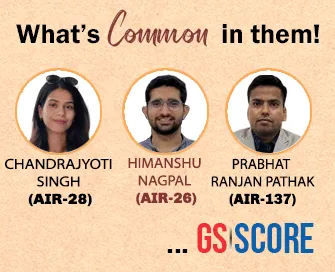
Editorials
Context
A 42-year-old woman in Malappuram district, Kerala, tested positive for the Nipah virus, marking the third reported case in the district within two years. With previous spillovers and outbreaks, this recurrence underscores a growing epidemiological concern in the region.
Epidemiological Trends and Clinical Profiles
- Increasing Frequency of Occurrence: Kerala has recorded two outbreaks involving human-to-human transmission (2018 and 2023) and four spillovers (2019, 2021, and twice in 2024), suggesting a pattern of regular re-emergence.
- Clinical Variation in Presentations: Spillover cases mostly exhibit Acute Encephalitis Syndrome (AES), while outbreak cases involve Acute Respiratory Distress Syndrome (ARDS), which is linked with greater severity and transmissibility.
- Transmission Pathways and Severity Correlation: ARDS patients carry higher viral loads, especially in the throat, combined with cough symptoms, increasing the likelihood of human-to-human transmission, which correlates with fatality rates — 17 deaths out of 18 cases in 2018, and 2 out of 6 in 2023.
Virological Insights and Research Findings
- Genetic Mutation Concerns: The 2018 Nipah virus strain showed minor genetic differences from the Bangladesh strain, capable of causing multisystemic disease in animal models (Syrian hamsters), mimicking human pathology.
- Significance of Viral Load and Sample Type: Regardless of other biological samples, throat swabs consistently test positive in infected individuals, especially those with ARDS, making it a crucial indicator for transmissibility risk.
- Diversity in Viral Behaviour: The Nipah virus demonstrates a broad clinical spectrum and inconsistent transmissibility, necessitating continuous surveillance and genomic mapping to understand its evolving nature.
Policy Imperatives and Surveillance Strategies
- Routine Surveillance of Fruit Bats: As fruit bats are the natural reservoir of Nipah virus, systematic and periodic monitoring of their virology is essential for early warning systems and understanding zoonotic dynamics.
- Urgency for Open Genetic Data Sharing: To enable timely research and global collaboration, genetic sequences of the virus must be deposited in public databases, allowing real-time tracking of mutations.
- Need for Institutionalised Genomic Studies: A robust mechanism involving multi-institutional and interdisciplinary genomic surveillance, especially in high-risk zones like Kerala, is necessary to pre-empt outbreaks and refine policy responses.
Practice Question
Q. With the increasing regularity of Nipah virus spillovers and outbreaks in India, especially in Kerala, critically evaluate the need for genomic surveillance, zoonotic monitoring, and public health preparedness as part of India’s epidemic response strategy.



